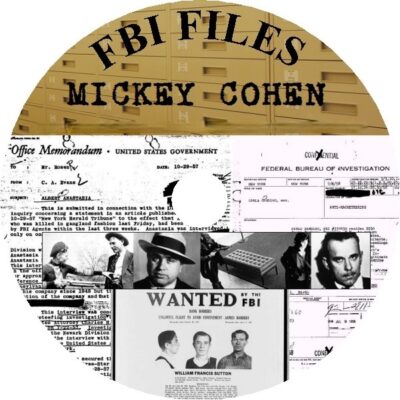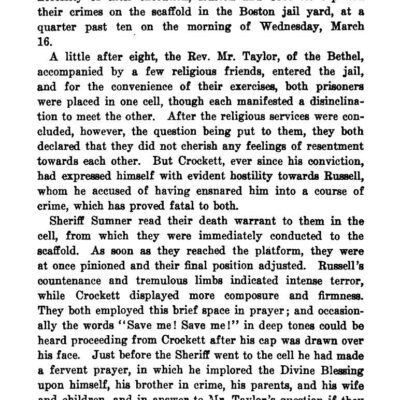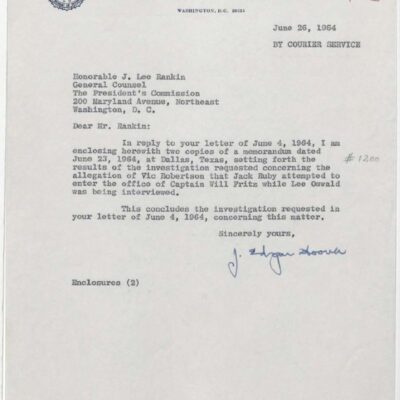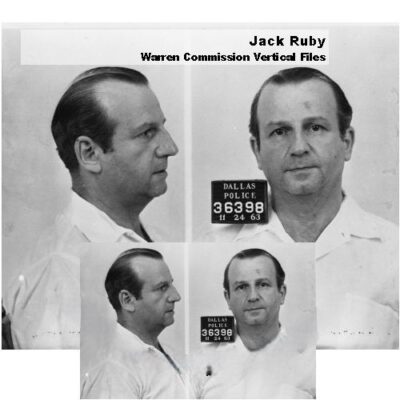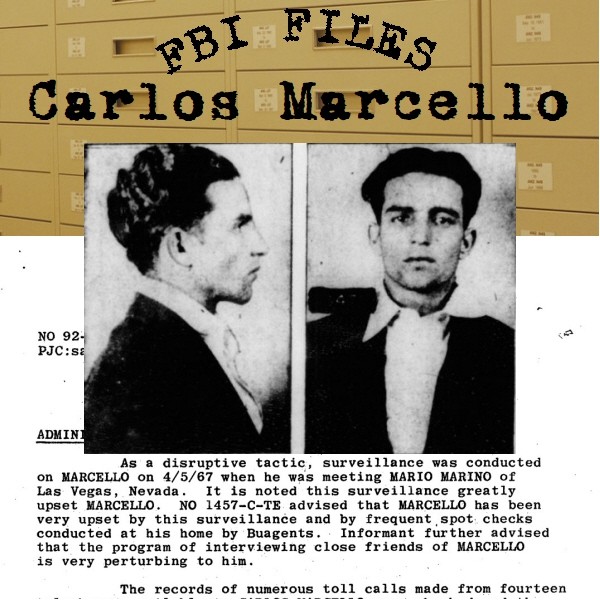
Carlos Marcello: ‘Godfather of New Orleans’ – FBI Files & Investigative Records
$19.50
Description
Carlos Marcello: FBI Files Timeline and Key Figures
Timeline of Events Related to Carlos Marcello
This timeline is based on the provided excerpts from “Carlos Marcello – “The Godfather of New Orleans” FBI Files and investigative Bodies’ Material.”
- 1910: Calogero Minacore (later known as Carlos Marcello) is born in Tunis, Tunisia, to Sicilian parents. The family immigrates to New Orleans later that year.
- November 29, 1929: At age 19, Marcello is arrested by New Orleans police as an accessory before and after the robbery of a local bank. The charges are subsequently dismissed.
- May 13, 1930: Marcello is convicted of assault and robbery and sentenced to 9 to 14 years in the State penitentiary.
- 1935: After receiving a pardon from the Governor of Louisiana, Marcello’s criminal activities continue. Charges are filed against him for a second assault and robbery, violation of Federal Internal Revenue laws, assault with intent to kill a New Orleans police officer, and another assault and robbery. He is not prosecuted on these charges.
- 1938: Marcello, now reputed to be the New Orleans family boss, is sentenced to 1 year and 1 day in an Atlanta penitentiary and fined $76,830 for his involvement in “the biggest marijuana ring in New Orleans history.” He serves less than 10 months and settles his fine for $400.
- Late 1930s – 1950s: Over these years, Marcello faces various other charges, including narcotics sale, a high-speed automobile chase, and assaulting an investigative reporter. These charges are never prosecuted. Aaron M. Kohn of the Metropolitan Crime Commission later reports that the records for these cases disappeared.
- 1947: According to an FBI memo from 1978, Carlos Marcello becomes the boss of the New Orleans La Cosa Nostra (LCN) family, a position he holds until the late 1980s.
- 1950 – 1980: The Department of Justice report “Organized Crime in the United States: A Review of the Public Record (1982)” covers investigations and organized crime control activities during this period, including investigations involving Marcello.
- 1951 – 1991: The FBI compiles files on Carlos Joseph Marcello, with records originating from bureaus in Dallas, Detroit, Minneapolis, New Orleans, and FBI headquarters.
- 1952 – 1972: The FBI focuses on efforts to deport Marcello to Guatemala.
- 1957 – 1992: Additional FBI files are collected, covering a wide range of Marcello’s activities and including material of interest to the House Select Committee on Assassinations and the JFK Assassination Records Review Board.
- 1959: Aaron M. Kohn, director of the Metropolitan Crime Commission of New Orleans, Inc., tells the McClellan Committee that records for previous cases against Marcello have disappeared.
- 1961: The McClellan Committee holds hearings investigating organized crime, with significant testimony about and by Carlos Marcello.
- April 4, 1961: The U.S. Justice Department, under Attorney General Robert F. Kennedy, apprehends Marcello in New Orleans and deports him to Guatemala.
- June 1961: Marcello returns to New Orleans.
- By 1963: The Metropolitan Crime Commission estimates Marcello’s ventures are grossing hundreds of millions of dollars annually from illegal gambling, syndicate-connected bars, burglaries, prostitution, and legitimate investments.
- November 1963: Marcello is tried for “conspiracy to defraud the United States government by obtaining a false Guatemalan birth certificate” and “conspiracy to obstruct the United States government in the exercise of its right to deport Carlos Marcello.” He is acquitted on both charges. The FBI also begins investigating Marcello following the assassination of President Kennedy, due to theories suggesting his involvement.
- October 1964: Marcello is charged with “conspiring to obstruct justice by fixing a juror [Rudolph Heitler] and seeking the murder of a government witness [Carl Noll].” He is acquitted of both charges.
- September 1966: Marcello is among 13 members of New York, Louisiana, and Florida crime families arrested for “consorting with known criminals” in Queens, New York. The charges are later dropped.
- Several Days After September 1966: Upon returning to New Orleans, Marcello is arrested for assaulting an FBI agent. His first trial results in a hung jury, but he is retried and convicted, receiving a two-year sentence. He serves less than six months.
- Late 1970s – Early 1980s: FBI files document Marcello’s mental condition before his release from prison.
- 1979: The House Select Committee on Assassinations releases its Final Report and Appendix on Organized Crime, both containing substantial references to Carlos Marcello in the context of a potential organized crime role in the assassination of President Kennedy.
- 1981: Carlos Marcello, along with Aubrey W. Young, Charles E. Roemer II, and two others, are indicted in the BRILAB investigation for conspiracy, racketeering, and mail and wire fraud in a scheme to bribe state officials for multimillion-dollar insurance contracts.
- 1980: The Department of Justice report “Organized Crime in the United States: A Review of the Public Record (1982)” covers this period.
- 1981: The Department of Justice report “Organized Crime in the United States: A Review of the Public Record (1987)” reviews organized crime up to this year.
- 1989: The 5th U.S. Circuit Court of Appeals throws out Marcello’s BRILAB conviction, and he is released from prison.
- Early 1989: Marcello suffers a series of strokes.
- 1989: The FBI interviews August James Russo, Marcello’s prison roommate, about Marcello.
- March 2, 1993: Carlos Marcello dies at his home in Metairie, Louisiana.
Cast of Characters
- Carlos Marcello (Calogero Minacore): (1910–1993) Born in Tunisia to Sicilian parents and immigrated to New Orleans. Ruled the New Orleans crime family from 1947 until the late 1980s. Involved in various rackets including gambling, narcotics, and legitimate businesses. Faced numerous arrests and charges throughout his life, but was often acquitted or charges were dropped. Deported to Guatemala in 1961 but quickly returned. Some JFK conspiracy theories suggest his involvement in the assassination. Convicted in the BRILAB case in 1981, but the conviction was overturned in 1989.
- Robert F. Kennedy: (1925–1968) United States Attorney General during the Kennedy administration. The Justice Department under his direction apprehended and deported Marcello in 1961.
- Aaron M. Kohn: Director of the Metropolitan Crime Commission of New Orleans, Inc. In 1959, he testified before the McClellan Committee about the disappearance of records related to past charges against Marcello.
- Rudolph Heitler: A juror in Marcello’s 1964 trial for conspiracy to obstruct justice. Marcello was accused of bribing Heitler. Marcello’s attorney admitted Heitler had been bribed.
- Carl Noll: A government witness in Marcello’s 1964 trial. Marcello was accused of seeking Noll’s murder. Noll refused to testify against Marcello in the case.
- Aubrey W. Young: Former aide to Governor John J. McKeithen. Indicted along with Marcello in the 1981 BRILAB case for conspiracy, racketeering, and mail and wire fraud.
- Charles E. Roemer II: Former commissioner of administration to Governor Edwin Edwards. Indicted and convicted with Marcello in the 1981 BRILAB case.
- Morey Sear: U.S. District Judge who presided over the BRILAB trial and allowed the admission of secretly recorded conversations.
- William H. Webster: Director of the FBI in 1978, who stated in a memo that “Carlos Marcello is a top ranking LCN official in the United States and has been boss of the New Orleans LCN since 1947.”
- August James Russo: Marcello’s prison roommate in 1989 at the Bureau of Prisons Medical Facility in Rochester, Minnesota. He acted as Marcello’s personal body servant and was interviewed by the FBI.
- John J. McKeithen: Governor of Louisiana during the time Aubrey W. Young served as his aide.
- Edwin Edwards: Governor of Louisiana during the time Charles E. Roemer II served as his commissioner of administration and when the BRILAB bribery scheme allegedly took place.
Carlos Marcello: ‘Godfather of New Orleans’ – FBI Files & Investigative Records
6,156 pages of FBI Files, House Select Committee on Assassinations Files and finished reports from the McClellan Committee, Department of Justice and the House Select Committee on Assassinations, reports that have substantial portions covering Marcello.
Carlos Marcello (1910–1993), was born Calogero Minacore in Tunis, Tunisia of Sicilian parents, who immigrated to New Orleans later that year. Marcello ruled the New Orleans crime family from 1947 until the late 1980s. Some JFK conspiracy theorists believe Marcello had a role in the assassination of the President. The Bureau investigated Marcello following the assassination of President Kennedy in 1963.
Marcello became active in all phases of the rackets in the New Orleans area. He operated casinos, horse betting parlors, slot machines and narcotics. Marcello invested heavily in legitimate businesses, including bars, restaurants, inns and food processing concerns, particularly seafood and other frozen foods.
Marcello’s first contact with the law came on November 29, 1929, when he was arrested at the age of 19 by New Orleans police as an accessory before and after the robbery of a local bank. The charges were subsequently dismissed. Less than 6 months later, on May 13, 1930, he was convicted of assault and robbery and was sentenced to the State penitentiary for 9 to 14 years. He served less than 5 years.
In 1935, after receiving a pardon by the Governor of Louisiana, Marcello’s early underworld career continued, with charges being filed against him for a second assault and robbery, violation of Federal Internal Revenue laws, assault with intent to kill a New Orleans police officer, and yet another assault and robbery. Marcello was not prosecuted on the various charges.
In 1938, Carlos Marcello, now the reputed New Orleans family boss, was sentenced to 1 year and 1 day in an Atlanta penitentiary, and a $76,830 fine when federal agents broke up, “the biggest marijuana ring in New Orleans history.” Marcello served less than 10 months and arranged to settle his fine for $400.
Other charges were brought against Marcello over the next several years, stemming from such alleged offenses as narcotics sale, a high-speed automobile chase, and assaulting an investigative reporter; these were never prosecuted. Aaron M. Kohn, director of the Metropolitan Crime Commission of New Orleans, Inc., told the McClellan Committee in 1959 that the records for these cases had disappeared.
On April 4, 1961, the U.S. Justice Department, under the direction of Attorney General Robert F. Kennedy, apprehended Marcello as he made what he assumed was a routine visit to the immigration authorities in New Orleans, then deported him to Guatemala. Two months later, he was back in New Orleans. Thereafter, he successfully fought efforts by the government to deport him.
By 1963, Carlos Marcello was one of the wealthiest men in Louisiana. His ventures, according to the Metropolitan Crime Commission, were grossing many millions annually: $500 million from illegal gambling; $100 million from illegal activities in over 1,500 syndicate-connected bars; $8 million from professional burglaries and hold-ups; $6 million from prostitution; and $400 million from diverse legitimate investments in transportation, finance, and housing. Marcello claimed he only earned, ” a salary of $1,500 a month as a tomato dealer, although he did acknowledge making certain “land investments.”
In November 1963, Marcello was tried for “conspiracy to defraud the United
States government by obtaining a false Guatemalan birth certificate” and “conspiracy to obstruct the United States government in the exercise of its right to deport Carlos Marcello.” He was acquitted later that month on both charges. However, in October 1964, Marcello was charged with “conspiring to obstruct justice by fixing a juror [Rudolph Heitler] and seeking the murder of a government witness [Carl Noll].” Marcello’s attorney admitted Heitler had been bribed but said that there was no evidence to connect the bribe with Marcello. Noll refused to testify against Marcello in the case. Marcello was acquitted of both charges.
In September 1966, 13 members of the New York, Louisiana and Florida crime families were arrested for “consorting with known criminals” at the La Stella Restaurant in Queens, New York. However, the charges were later dropped. Returning to New Orleans a few days later, Marcello was arrested for assaulting an FBI agent. His first trial resulted in a hung jury, but he was retried and convicted. He was sentenced to two years but served less than six months.
In 1981, Marcello, Aubrey W. Young (a former aide to Governor John J.
McKeithen), Charles E. Roemer, II (former commissioner of administration to
Governor Edwin Edwards), and two other men were indicted in the U.S. District Court for the Eastern District of Louisiana in New Orleans with conspiracy, racketeering, and mail and wire fraud in a scheme to bribe state officials to give the five men multimillion-dollar insurance contracts. The charges were the result of a Federal Bureau of Investigation probe known as BRILAB. U.S. District Judge Morey Sear allowed the admission of secretly recorded conversations that he said demonstrated corruption at the highest levels of state government. Marcello and Roemer were convicted. Marcello was sentenced to 7 years. In 1989, the 5th U.S. Circuit Court of Appeals threw out Marcello’s BRILAB conviction, and he was released from prison.
Early in 1989, Marcello suffered a series of strokes. He died at his Metairie, Louisiana, home on March 2, 1993.
This collection contains:
FBI Files – Dallas Detroit Minneapolis New Orleans Bureaus & D.C. Headquarters
1,419 pages of FBI files dating from 1951 to 1991 covering Carlos Joseph Marcello. Documents produced by and sent to FBI bureaus in Dallas, Detroit, Minneapolis, New Orleans, and FBI headquarters in Washington & D.C. A 1978 FBI memo from Director William H. Webster states, “Carlos Marcello is a top ranking LCN official in the United States and has been boss of the New Orleans LCN since 1947.”
Prominent coverage in the files is given to:
Abstracts concerning alleged criminal activity by Marcello in the 50s and 60s.
Memos concerning the federal government’s effort to deport Marcello to Guatemala from 1952 to 1972.
Information about the FBI interviewing August James Russo, Marcello’s prison roommate in 1989 at the Bureau of Prisons (BOP) Medical Facility at
Rochester, Minnesota. Russo acted as Marcello’s personal body servant at the prison.
Marcello’s mental condition in the late 1970’s and early 1980’s before his release from prison.
Information about BRILAB (Bribery Labor), a federal corruption investigation into activities into racketeering activities in Louisiana and Texas, which led to the indictment of Marcello.
FBI Files – Cross-References ARRB Collected
440 pages of FBI Files dating from 1957 to 1992. Coverage of a wide range of activities conducted by Marcello during this period. Also, includes files of interest to the House Select Committee on Assassinations and the JFK Assassination Records Review Board.
House Select Committee on Assassinations Files
645 pages of Committee generated files and files collected by the Committee, with content related to Marcello. Marcello’s name appears 55 times in these pages.
Reports That Have Substantial Portions Covering Marcello
Organized Crime in the United States: A Review of the Public Record (1982)
A report commissioned by the Department of Justice. This document provides an extensive overview of the history and activities of, and law enforcement response to organized crime in the United States. Part 1, pages 1 to 438, part 2 of this report is missing. Historical materials cover investigations and organized crime control activities undertaken from 1950 to 1980, including the Kefauver and McClellan investigations, activities under the Kennedy administration, and the organized crime program.
Organized Crime in the United States: A Review of the Public Record (1987)
This 136-page study reviews the characteristics, events, and activities associated with organized crime from its emergence in the United States in 1890 up to 1981, based on the public record, notably congressional hearings, Federal reports, and books by recognized authorities on organized crime.
House Select Committee on Assassinations Final Report (1979)
The 716-page presentation to the House of Representatives of the findings and recommendations of the Select Committee on Assassinations. Marcello’s name appears 74 times in this report.
Appendix to Hearings Before the Select Committee on Assassinations U.S. House of Representatives Ninety-Fifth Congress Second Session: Volume IX Staff and Consultants Reports on Organized Crime (March 1979)
1,178 pages of House Select Committee on Assassinations Reports related to its investigation into organized crime.
Abstract: Early in its investigation, as soon as it was realized that a plot by elements of organized crime in the United States to assassinate President Kennedy warranted serious consideration, the committee decided to assemble the most reliable information available on the subject. The focus was to be primarily on the history of organized crime; the impact of the Kennedy administration’s campaign against it in the United States; possible links of Lee Harvey Oswald and Jack Ruby with underworld figures; and the development of new evidence or leads. From this information, the committee hoped to discover if the national syndicate of organized crime, or any of its leaders or members, had the motive, means and opportunity to assassinate the President, and if there was any evidence of their participation in the events in Dallas on November 22, 1963.
McClellan Committee Investigating Organized Crime Hearings First Session (1961)
1,165 pages of Committee hearing transcripts, including much testimony about and by Carlos Marcello.
Transcript of Gambling and Organized Crime Hearings of the Permanent
Subcommittee on Investigations or the Committee on Government Operations United States Senate Eighty-Seventh Congress First Session Pursuant to Senate Resolution 69, 87th Congress Part I. August 22, 23, 24, and 25, 1961 .

